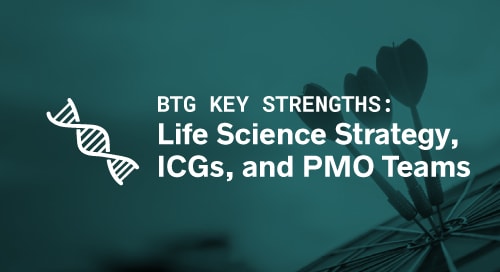
Across the life sciences, one of the biggest pain points plaguing companies and business leaders today is cost pressures stemming from the turbulent economy and an uncertain outlook ahead. While costs are a hot topic for everyone, life science leaders are seeing circumstances unique to their industry and laser focusing on cost reduction strategies to help keep things moving amid disruptions. No surprise then that, in these conditions, Business Talent Group (BTG) has seen an influx of demand for operations leaders experienced with all things cost related as leaders navigate needs that can quite literally be life altering for the patients they serve.
In order to provide on-the-ground insights to help life science leaders think about how they can optimize costs and operations in this moment, we’ve turned to Patrick Groody, an experienced senior Abbot leader with broad expertise in the medical diagnostics industry who is skilled at accelerating business performance improvement organization-wide.
Meet The Expert

Patrick Groody
A business leader with more than 30 years experience in the life sciences industry and a track record of success delivering new products, driving business process improvements, implementing cultural changes, and developing leaders.
While cost pressures are a cross-industry pain point right now, what are some pressures that are specific to the life sciences?
General inflationary pressures are causing pain points across industries right know. In the life sciences, companies often need highly skilled workers for product development, manufacturing, and technical product support roles. Current labor shortages are making it increasingly difficult to fill these positions, and labor costs are therefore significantly higher.
Life science products also frequently have unique and challenging storage requirements or limited stability dating, and this often results in complex shipping and storage costs. As transportation, fuel, and energy costs have increased, this had a significant cost impact on these areas.
Finally, since many raw materials are sourced globally, the general lack of supply resulting from the lingering effects of the COVD pandemic continues to put pressure on key raw material costs for life science products.
How have concerns like those you mentioned changed in the past few years? What impact are they having on operations in life science organizations today?
Many of the challenges began during the COVID pandemic, and while there has been some relief, many of those challenges remain. Demand for healthcare products remains high even as demand for discretionary consumer products has started to decrease. Raw material shortages, especially for materials sourced from China and countries where COVID lockdowns remain, continue to cause supply disruptions.
Supplies that used to have reliable lead times are now often on back order for weeks or months. As a result, companies are having to readjust manufacturing schedules more frequently, thereby leading to an increase in plant inefficiencies. Additionally, many companies have had to reconsider and increase raw material inventories in order to sustain a reliable production plan. Finally, sustained high fuel prices and labor shortages in the transportation sector continue to drive significant increases in distribution costs.
What are the biggest opportunities for life science leaders to take cost out of the business right now? How can leaders go about prioritizing them?
Companies need to take a more comprehensive approach to cost reduction. Often, cost reduction efforts focus on finding less expensive alternatives for raw materials or packaging. While this can lead to substantial savings, raw material suppliers now have more leverage, and that “low-hanging fruit” is more difficult to harvest.
It’s now increasingly important to comprehensively examine all aspects of the value chain. This includes identifying areas of process inefficiency, reducing process variability, reducing costs associated with poor product quality, and reallocating resources to drive sustainable efficiencies in both the direct labor and indirect labor parts of the organization.
These are also times of significant market uncertainty. Companies need to nimble. They need to ensure they have processes and plans in place to deal with market changes and disruptions so they can adapt quickly and avoid both inventory excesses and inventory shortages that may otherwise occur.
What are some of the most important things for companies to keep in mind as they move from strategically planning cost reduction initiatives into implementation?
It’s important to stay focused on the long-term objectives and make sure the actions being taken will achieve sustainable reductions in cost. Too often companies look for quick fixes. Although this can produce short-term savings, the results are often not sustainable because the real drivers of cost inefficiency have not been adequately addressed. It’s critical to make sure progress is measured on an ongoing basis. Failure to do so can often result in cost savings creeping right back into the organization.
How can companies ensure that their cost reduction efforts don’t negatively impact product quality and organizational effectiveness?
Maintaining product quality is essential in today’s market. Customers simply won’t stay with a firm that doesn’t produce quality products, as there are often plenty of good alternatives available. Changes in raw materials, suppliers, and manufacturing processes need to be thoroughly tested and validated prior to market in order to ensure product quality and performance are not compromised. Once the changes are implemented, regular review of complaints and other customer feedback data needs to be carefully monitored to ensure changes have not yielded any adverse consequences.
Looking forward, how can organizations effectively forecast and prepare for operational cost variables in the uncertain economic environment?
Forecasting is always difficult since no one knows for sure what the future looks like. The best companies have good processes in place for assumption management. Their plans and strategies are built upon both controllable and uncontrollable assumptions, which are monitored frequently and on a regular basis. By monitoring changes in assumptions continuously, companies have better opportunities to proactively adjust plans when things they assumed don’t materialize.
What makes experts like you an effective solution for companies seeking to strategically approach cost reduction?
Sometimes an outside expert can provide a different perspective and can challenge the assumptions and plans which have been generated internally. Also, many external consultants have the advantage of having had experiences working with many different companies. As a result, they have often seen the differences between plans that work and lead to sustainable savings and those that do not.
How can organizations ensure that transformations related to cost reduction create meaningful, sustainable change?
The key is to be strategic in formulating plans that will have long-term impact. Too often companies are focused on short-term, tactical actions that don’t produce long-term results. Sustainable change requires solving for the key driver of the cost inefficiency and ongoing due diligence to ensure it has a lasting impact.
Find the answers to your cost pressures questions with experts like Patrick.
Business Talent Group’s network includes 4,600+ independent life science consultants, subject matter experts, boutique firms, project managers, and executives. Our talent have advanced degrees, specialized expertise, traditional consulting training, and hands-on experience. We serve:
- 13 of the top 15 largest pharmaceutical companies
- 6 of the top 10 biotech companies
- 8 of the top 10 medical device companies
See why more than 50% of the Fortune 100 and hundreds of other leading companies trust BTG to curate, vet, and compliantly deliver talent who fuel growth, innovation, and performance improvement.
GET THE SKILLS YOU NEED
Thousands of independent consultants, subject matter experts, project managers, and interim executives are ready to help address your biggest business opportunities.























